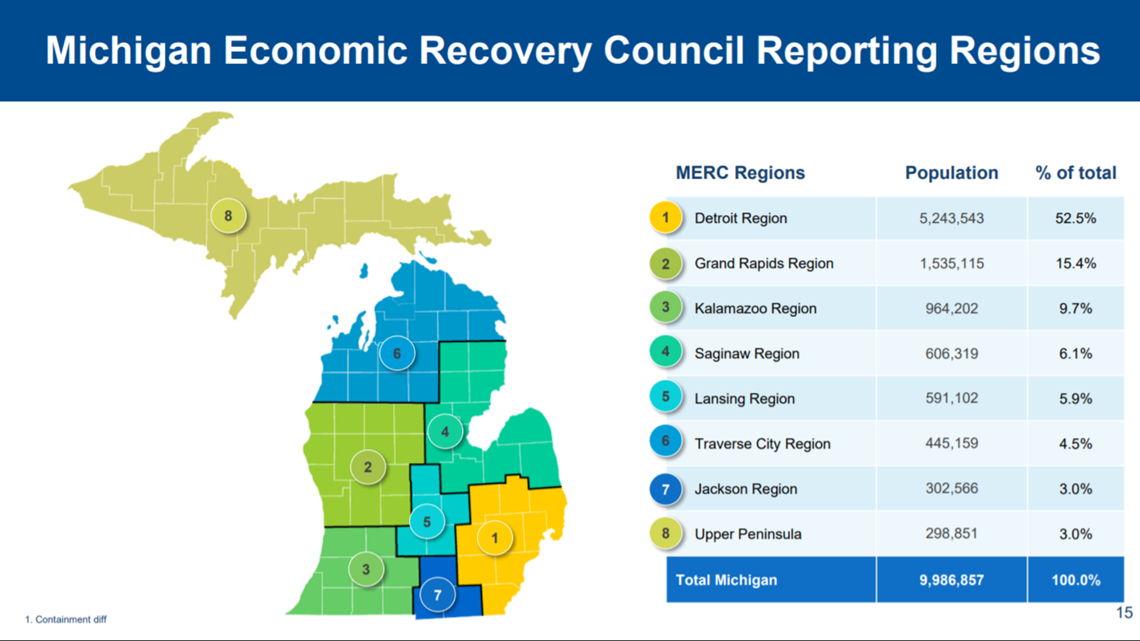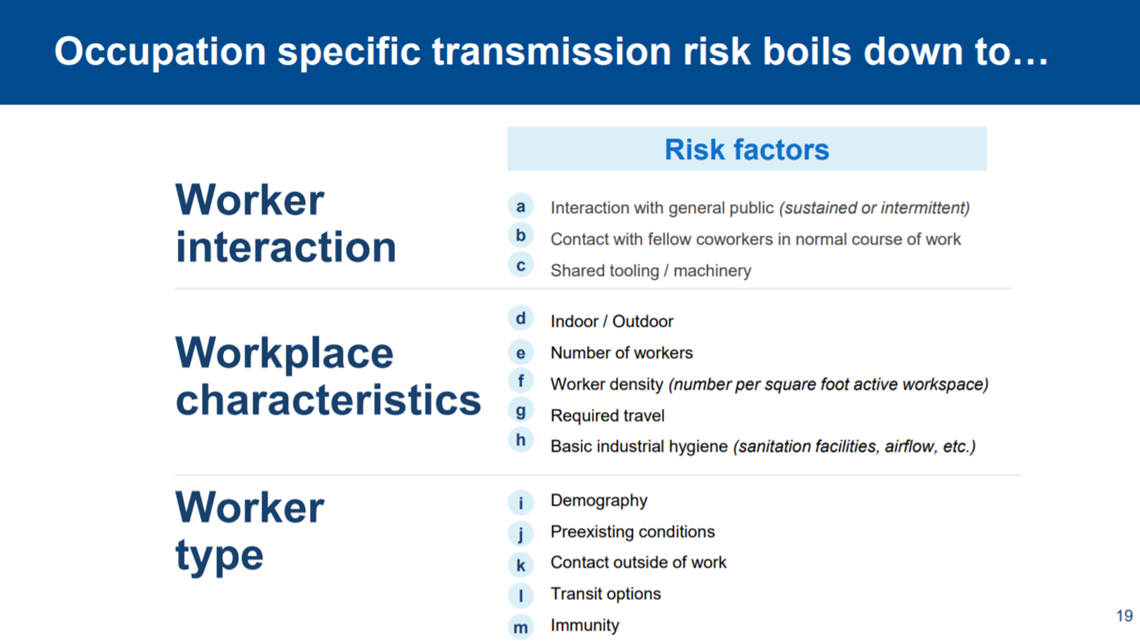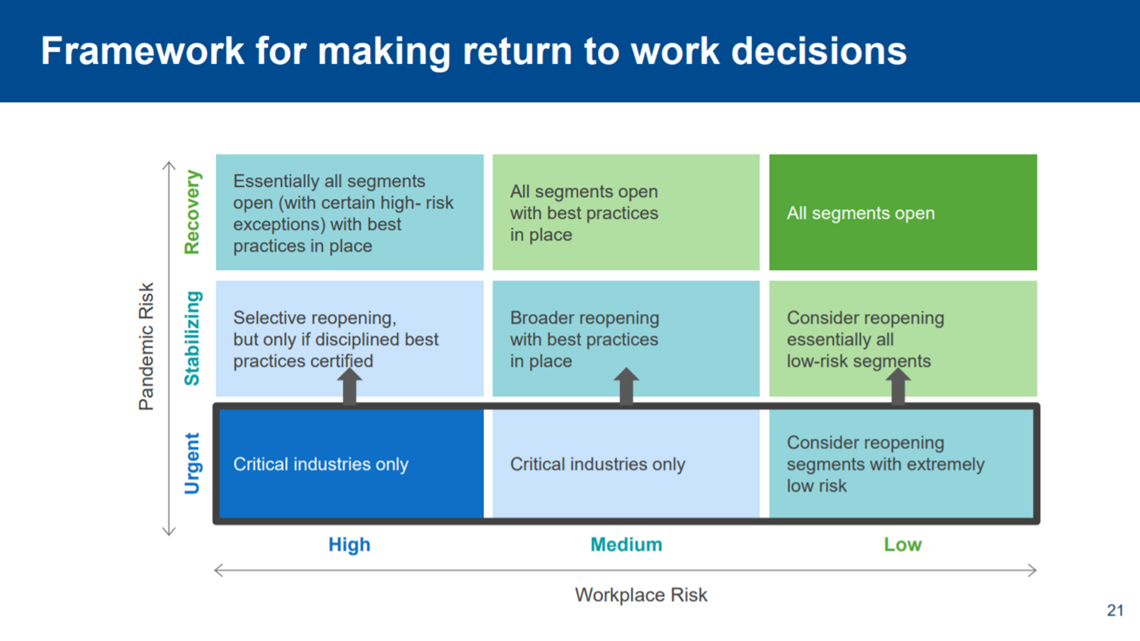LANSING, Mich. — Cases of coronavirus are plateauing in Michigan, but Gov. Gretchen Whitmer said during a Monday briefing that shutting down the state in the face of COVID-19 was easier than it will be to get everything running again.
"Stopping is simple--doesn't mean it's easy, but it's simple," said Whitmer. "But re-engaging is complicated."
The current stay at home order is in place until May 15, and it only allows essential employees to report to work and it relaxed restrictions on a few low-risk industries, including landscaping and lawn-care services.
Whitmer said in the next week or so, she anticipates to make an announcement that more outdoor industries and construction will also be able to return to work. She also said state leaders are looking at a number of industrial sectors to potentially restart soon as well.
"There's no on and off switch here," the governor said. "We have to think about this as a dial: where we turn it up when necessary, where turn it down when necessary. Re-engagement needs to be incremental and cautious."
The state has deemed the approach the MI Safe Start Plan.
In order to broadly move the state toward re-engaging, the state has developed a Michigan Economic Recovery Council (MERC) to put the state on the path to restoring the economy in light of the pandemic that crippled workforces.
During Monday's briefing, Gerry Anderson, the executive chairman for DTE Energy, and Wright Lassiter, the president and CEO of Henry Ford Health, provided a framework for how the state will begin to reopen. The MERC will be using two categories to guide when and how sectors of the state will reopen: geography and workplace.
MICHIGAN'S 8 REGIONS


Certain areas of Michigan have been hit harder by the coronavirus than others. So in looking at reopening, MERC divided the state into eight regions.
"It turns out that geography is really important," said Anderson. "This disease and how it presents varies across the state."
The regions were determined by examining the labor shifts, which is how people commute to work and how far they need to travel. Lassiter said this is a key component because the disease is carried through the movement of people.
The second major aspect of defining the regions was how robust their healthcare systems are.
"The nature of hospital systems like my own, and their capacity to deal with the COVID-19 outbreak vary significantly across regions and across the state," said Lassiter.
Dr. Joneigh Khaldun also indicated that while statewide coronavirus cases, deaths and hospitalizations are trending down, there are some areas of Michigan where their hospital ICUs remain at capacity.
MERC will use that criteria to determine how regions can begin to re-engage.
WORKPLACE RISKS


Certain low-risk workplaces have already been allowed to return to work before the stay at home order was lifted. But MERC will be looking at the risks of each industry to determine how and when it will be able to resume operations.
The entire state's workforce has been divided into nine types of workplaces:
- Office (29% of the state)
- Industrial (19% of the state)
- Healthcare (13% of the state)
- Retail (12% of the state)
- Restaurant and Lodging (8% of the state)
- Schools (6% of the state)
- Construction (4% of the state)
- Outdoor (4% of the state)
- Other (4% of the state)
"We worked with public health experts to understand the risk of virus transmission in each of those workplace types, as well as the practices that we can use in various workplaces to minimize risk," said Anderson.
The state has developed a team for each type of workplace, it will be led by an industry executive and will include labor leaders and public health experts.
"The risk of disease transmission is different if you work in a hospital for instance versus a retail outlet, a manufacturing plant or if you are engaged in an outdoor work activity. And so it was important for us to break down Michigan's labor force across workplace types," said Lassiter.
The risk factors that will be considered in allowing certain industries to return to work include: worker interaction, how much of the job involves interacting with the general public or close contact with coworkers; workplace characteristics, if it's indoor or outdoor, the number of employees and worker density; and worker type, the demography, underlying health conditions and transit options.
Occupational health experts with the University of Michigan assigned each type of workplace a risk score. But Anderson said that score can be lowered by implementing best practices. These are:
- Access control: Conducting daily health screening of employees and limiting the number of people who visit the workplace
- Social distancing: Install restrictions on common areas and in-person meetings, plus promote remote work
- Sanitation/hygiene: Disinfecting facilities frequently, making hand washing facilities available
- PPE: Masks, gloves, face shields, gowns
- Contact tracing/isolation: Develop investigation standards if someone tests positive for the virus and isolation protocols
WHEN WILL THE STATE START TO REOPEN?


Monday, state leaders simply explained the framework they are using in determining how Michigan will be re-engaging its workforce. They did not detail which regions or industries will be reopening first.
"There's no hard and fast timeline here as we set dates," said Whitmer. "We will continue to keep you informed. There may be instances where we can move faster. There may be instances where we need to move a little slower."
Whitmer said that the state needs to be nimble if they see signs of a second wave, to be able to step back on some industries that may have reopened. The governor said no one knows what the coming months will bring, but she emphasized that officials are using data to guide their decision making.
"When we build up our public health apparatus and work with employers to keep you safe in the workplace, we can safely, slowly start to re-engage. And no one wants to do that more than I do, I can tell you that," Whitmer said.
See the slides from the press briefing here. And watch the entire news conference here:
More stories on 13 ON YOUR SIDE:
►Make it easy to keep up to date with more stories like this. Download the 13 ON YOUR SIDE app now.
Have a news tip? Email news@13onyourside.com, visit our Facebook page or Twitter. Subscribe to our YouTube channel.

